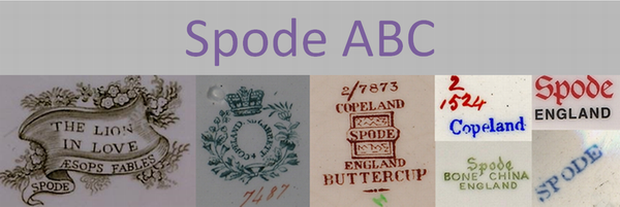Either a hot water can from a toilet ware set - click Spode and Hot Water to find out more
OR
A miniature watering can made in the early 1800s and again in the 20th century. The earlier ones were very expensively decorated and made in bone china. They were known as Toys and usually aimed at wealthy ladies who collected these exquisite little items rather than as toys for children as we know today. You can see a page from a Spode 1820 shape book featuring a toy watering can if you click here then select 'Toys' and go to page 18. The finished size of the toy would be about 2 inches high.
Wellington, Duke of
There are several connections between Spode and the Duke of Wellington. Click HERE> for my blog 'Spode, Copeland, Waterloo and the Duke of Wellington'.
 |
| Backstamp on a bust of Wellington c1824 |
White Star Line
Click here for Spode & RMS Titanic.
Wig warmer
This is NOT a wig warmer! Go to the T-V page and find Vietnamese limepot and find out what it really is.
 |
| NOT a wig warmer |
Willow
Click here for Spode & Willow Pattern. The image below shows my snapshot of one of the dressers, in the Spode museum's 'Blue Room', in 2004. It holds Spode blue printed wares and handpainted Chinese porcelain pieces from the Spode museum and private collections dating from the 18th and early 19th centuries.
Wimbledon
See Tennis
Wine Cooler
Click here for Spode and Ice where you will find a mention of wine coolers. Also go to Ice Pail on the I-J page where there is an image of wine coolers from Spode's 1820 Shape Book. In the image here you can gauge the size of the wine coolers from the teapots in front.
 |
| Far left & far right elegant cobalt blue and gold wine coolers |
Wonders and Wonders of the World
This pattern is properly know as the Seven Wonders of the World so please go to the S page.
Woodman
Woodman was first produced in about 1816. It is a transfer printed pattern.
The central scene depicts a woodman leaning on his axe addressing a woman sitting with a child on her lap. The border features stylised flowers and foliage in white against blue.
A print, illustrated in 'Spode Transfer Printed Ware 1784 - 1833' by Drakard & Holdway dates from 1807 which is thought to be the source for the Spode design. The engraver of this print is recorded as Francis Eginton.
A print in black on silk, of the same scene, has been found inside a workbox. It is possible that the scene may depict the theme of a popular song or be taken from a print of the period.
 |
| Woodman teapot (with the wrong lid!) from the V & A collections |
Woodman was reintroduced in the late 1990s as part of Spode's Blue Room Collection. At the time of writing in 2014 the pattern is available from the Portmeirion Group under the Spode brand.

